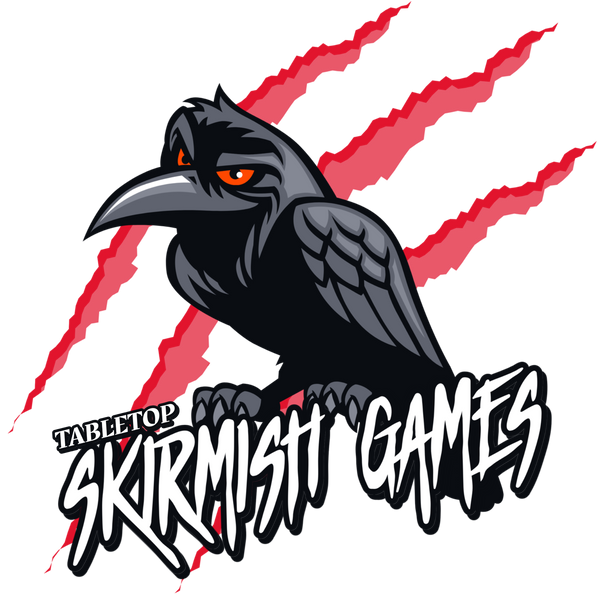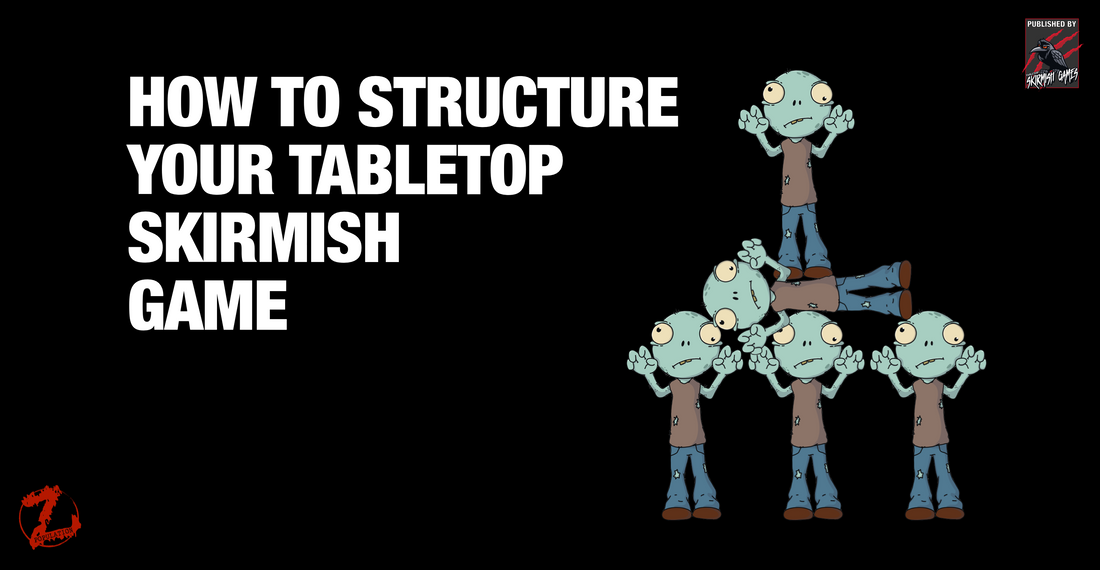How To Structure Your Tabletop Skirmish Game Rulebook
We've discussed many principles in previous blog posts, but now we'll start covering more practical information you can implement in your tabletop skirmish games. It doesn't get more practical than structuring a rulebook, so let's start there.
A well-structured rulebook is the cornerstone of a successful tabletop skirmish game. It serves as the player's guide to the intricate world you've created, providing them with the tools they need to navigate through the game. In this blog post, we'll cover the seven guidelines for structuring your rulebook, including layout, page order, and formatting, before looking at fonts in detail.
1. Establish Clear Sections and Chapters
Dividing your rulebook into clear sections or chapters is paramount for a player-friendly experience. Each section should focus on a specific aspect of the game, such as gameplay overview, components needed to play, character creation, setup sequence, turn structure, actions, and special rules. When working on a chapter, try not to talk about elements of the game you haven't covered yet. It will have to happen from time to time, but if it occurs frequently, it can be frustrating.
Presenting clear sections and chapters not only facilitates easy navigation but also helps players locate information swiftly. To enhance accessibility, think about incorporating visual cues like page headers. These subtle markers provide a quick reference point, allowing players to jump to the relevant section with ease during gameplay.
When planning out your sections, think about what naturally goes together. For example, in Population Z, I want the Survivor creation to be as close to the beginning as possible. In that section I include how to build a Group, how to build individual Survivors, weapons tables, and examples of Survivor cards. Everything the player needs is in one section, so they don't have to flick to a different part of the book to find any information. Once the Survivors are created, players can then move on and learn about the Key Concepts of the game.
2. Use a Logical and Intuitive Order
Presenting rules in a logical and intuitive order is key to helping players grasp the intricacies of your game. Organise rules in a sequence that mirrors the gameplay, moving from basic concepts to more advanced mechanics. This sequence ensures a smooth learning curve, especially for newcomers.
I like to create my characters, then learn how to move them around the battlefield, and then learn about all the actions they can carry out. Many tabletop skirmish games go through the core rules first and then how to create the characters once all the rules are learned. It is more immersive if you can create a character and then learn how to play the game with them in your mind. It strengthens the connection between players and characters, laying the foundation for more meaningful decision-making when gameplay begins.
3. Maintain Consistent Terminology
Maintain consistent terminology throughout the rulebook, and if you have to cross-reference between chapters, make sure the page number and heading are clearly stated. This clarifies potentially confusing terms and reinforces the connections between different aspects of the game.
It's a good idea to include a set of 'common terms' early in your rulebook in the game overview or introduction. In Population Z, I include common terms in the overview for Player, Survivor, Group, NPC, AI, GM, Skirmish, and Campaign. Doing this before players move on to the Group and Survivors section helps to get straight into the fun part of the game, creating Survivors.
In that example, the explanations are done beforehand, making for a nice, smooth transition from one section to the next. Players are primed and ready to get started with the basic information they need to build on as they progress through the rules.
4. Utilise Headings, Subheadings, and Bulleted Lists
Breaking down information into digestible chunks is crucial for readability. Employ headings, subheadings, bold text, and bulleted lists to structure your rules. Group related rules under appropriate headings to improve accessibility and use concise and descriptive subheadings to enable efficient rule location.
Bold text naturally draws the reader's attention. When used sparingly, it can highlight critical information, important rules, or key concepts. This helps ensure that players don't overlook crucial details that might impact their understanding or enjoyment of the game.
Bulleted lists are excellent for presenting information in a clear and concise manner, making it easier for players to absorb and understand the rules. The goal is to enhance comprehension without overwhelming the reader with dense blocks of text. As we talked about in a previous blog post, bullet points are perfect for abilities or special rules where there are a number of conditions. Players can clearly see the conditions and work through them in a logical order.
In Population Z, I use a lot of subheadings. Many times, there is only one paragraph beneath the subheading because that's all the information the players need. Don't feel like you have to add more flowery language or filler when only a paragraph is needed to convey the information.
5. Provide Visual Aids and Examples
Visual aids, diagrams, and illustrations can significantly enhance players' understanding of your game mechanics. Integrate visuals that illustrate gameplay concepts, spatial relationships, or tactical positioning. Ensure that clear explanations and labels for optimal understanding accompany these visual elements.
Consider including examples that showcase how specific rules or mechanics work in practice. Real-world scenarios help players apply theoretical knowledge, making the learning process more engaging and effective.
A mix of illustrations, diagrams and photographs makes the visual aids more appealing. Bolt Action gets this mix right, especially in their campaign books. Their use of photography and illustrations creates an appealing aesthetic but also gives players a lot of information in a clear and concise way.
6. Include a Comprehensive Index and Glossary
A comprehensive index and glossary are invaluable tools for players seeking quick rule lookups and clarification. Categorise terms, concepts, and references systematically, making it easy for players to find the information they need.
Cross-reference related terms or concepts to provide a holistic understanding of the game's mechanics. This not only aids in rule clarification but also reinforces the interconnected nature of different elements within your tabletop skirmish game.
An Index and Glossary can often be an afterthought and can be rushed or even left out altogether. I recommend spending a lot of time on these. When you've written your book, go right through it page by page and write down every term, concept, and reference that you think players will want to look up. When it comes time to play-testing, set aside some sessions to focus on the index to test it out and find any missing terms that should be in there.
7. Layout and Typography
An aesthetically pleasing layout and legible typography contribute significantly to the overall user experience. Choose clear fonts, appropriate sizes, and line spacing to enhance readability. Utilise whitespace, colour coding, or typography variations to draw attention to important information or key rules.
Your sections, headings, sub-headings and bullet points will work together to create a visual hierarchy, making it clear which sections are overarching topics and which are subsections.
A well-designed layout not only makes the rulebook visually appealing but also improves information retention. Players are more likely to engage with and enjoy a game that is presented in a visually appealing and easily readable manner.
Technical Details
In this section of the blog post, we'll focus on some practical information for fonts, font size and line spacing.
Fonts
The appropriate font size for headings can depend on various factors, including the overall design of your document, the chosen font type, and personal preferences. However, there are some general guidelines you can follow. Here are recommendations for font sizes for headings:
Main Headings (e.g., Chapter Titles):
Font Size: 18 to 24 points
These headings should be larger and bolder to clearly demarcate different sections or chapters in your rulebook.
Subheadings:
Font Size: 14 to 18 points
Subheadings provide a hierarchy within sections and should be smaller than main headings but still distinct.
Sub-subheadings:
Font Size: 12 to 16 points
If your rulebook has multiple levels of headings, such as sub-subheadings, keep the font size smaller but ensure there's enough contrast for readability.
Main Body:
Font Size: 10 to 12 points
For digital documents, especially those viewed on screens, a slightly larger font size may be more comfortable for reading. Consider a range of 12 to 14 points.
Line Spacing:
Regardless of the font size, pay attention to line spacing. A slightly larger line spacing, often expressed as a percentage of the font size (e.g., 120-150%), can enhance readability.
White Spacing:
Whitespace, also known as negative space, is a crucial design element that can greatly impact the readability, clarity, and overall aesthetics of your rulebook. Getting this right is a major part of the design structure and design process, so I'll cover this in detail in the next blog post.
Consistency Is Key
Maintain consistency in heading styles throughout your document. Use the same font family and ensure that the formatting (boldness, italics, spacing, etc.) is consistent across all headings, sub-headings and bullet points.
Ensure that your chosen font size provides good legibility. If your document is likely to be viewed on screens or printed in a smaller format, you might lean toward the larger end of the recommended font sizes.
Remember that these are general guidelines, and you should adjust them based on your specific design choices and the visual hierarchy you want to establish in your rulebook. Again, it's a good idea to test the readability of your headings with potential users or play-testers to ensure that they find the text straightforward and easy to follow.
How To Structure Your Tabletop Skirmish Game Rulebook
In conclusion, structuring your tabletop skirmish game rulebook with careful consideration of these guidelines is essential for creating a positive player experience. A well-organised and visually appealing rulebook not only facilitates learning but also enhances the overall enjoyment of the game.
By incorporating clear sections, logical ordering, effective headings, visual aids, a comprehensive index, and thoughtful layout and typography, you'll provide players with a roadmap to navigate the rich and immersive world you've created.
I hope you've found this blog post helpful. I'd love to hear your thoughts and opinions on the subject, so please join the conversation in the comments below.
Thanks for reading!
Lee
Look out for my new game, Population Z: Welcome to Huntsville, launching in January 2024.

